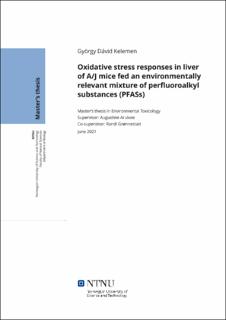Sammendrag
Recently, the adverse effects of perfluoroalkyl substances (PFASs), have been in the spotlight of several studies. Besides the known tumour inducing and endocrine disrupting characteristics of these chemicals, there has been reports about oxidative stress responses as well. In other words, PFASs are able to disrupt the balance of oxidising agents and antioxidant variable, therefore creating an increased amount of reactive oxygen species (ROS). In this master project, oxidative stress responses in the liver of A/J mice were examined, after exposure to an environmentally relevant mixture of PFASs. A total of 38 mice were included in the study, 20 in the control group (10 male, 10 female) and 18 in the exposed group (8 male, 10 female). After a 10-week dietary exposure period, the mice were sacrificed. Body and liver weights were measured along with PFAS concentrations in the liver. The oxidative stress biomarker responses were evaluated at transcript and functional levels. In addition, lipid peroxidation was measured as a general indicator of oxidative stress. The data show that liver weight increased at both sexes, significantly so in males. The transcript expression data showed a general pattern of increase in the exposed groups. Although the differences were rarely significant statistically. The pattern suggests that PFAS exposure had biological significance in connection with oxidative stress. The results of the enzyme activities did not correlate with the findings of the gene expression, suggesting the involvement of other PFAS-induced post-transcriptional and/or -translational activities. Lipid peroxidation showed similar pattern to the gene expression in male mice, which further suggests the presence of induced oxidative stress. The non-significant responses in female mice might indicate a possible role of sexual differentiation and the effect of increased systemic estrogen content that may have altered oxidative balance. Further experiments are advised, in order to properly evaluate the oxidative stress responses after PFAS exposure in mice. The examination of oxidative stress biomarkers along with post-transcriptional processes (such as the effects of RNA binding proteins) and receptor (e.g PPARs) profiles may play some roles in PFAS effects in rodents. These, together with the presence of sex hormones, liver enlargement, triacylglycerol accumulation, fatty acids oxidation should be further investigated in order to acquire a clearer picture of PFAS effects on oxidative stress response pathways.
